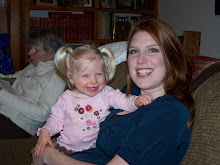Anyway - the information provided below is a detailed breakdown of the genetics of Angelman that was given to us from a geneticist that we saw in July. For those people that enjoy learning medical information, enjoy. For others, feel free to wait for the next post - this may give you a headache!
For comparison purposes, Aubrey is Deletion + meaning she has AS caused by an out right deletion of part of the 15th chromosome. As you'll soon read, this happens to be the most common form of AS, occurring in 70% of AS individuals.
<><><><><><><><><><><><><><><><><><><><><><><><><><<><><><>
Genetic basis of AS
For several decades the chromosome study of AS individuals revealed no abnormalities, but with the development of improved methods a very small deleted area was found in chromosome 15. Molecular methods such as FISH (fluorescence in situ hybridization) now demonstrate a deletion in about 70% of individuals with AS. The deleted area, although extremely small, is actually quite large when viewed at the molecular level. It is believed to be about 4 million base pairs in length, enough to contain many genes.
The deleted region on chromosome 15 is known to contain genes that are activated or inactivated depending upon the chromosome’s parent of origin (i.e., a gene may be turned on on the chromosome 15 inherited from the mother but off on the chromosome 15 inherited from the father). This parent-specific gene activation is referred to as genetic imprinting. Because the deletions seen in AS only occur on the chromosome 15 inherited from the mother, the gene(s) responsible for AS were predicted to be active only on the maternal chromosome 15. Disruption of genes that are active on the paternally-derived chromosome 15 is now known to cause another developmental disorder termed the Prader-Willi syndrome (PWS). The PWS gene(s) are actually located close to the AS gene, but they are different.
In 1997, a gene within the AS deletion region called UBE3A was found to be mutated in approximately 5% of AS individuals (22, 23). These mutations can be as small as 1 base pair. This gene encodes a protein called a ubiquitin protein ligase, and UBE3A is believed to be the causative gene in AS. All mechanisms known to cause AS appear to cause inactivation or absence of this gene. UBE3A is an enzymatic component of a complex protein degradation system termed the ubiquitin-proteasome pathway. This pathway is located in the cytoplasm of all cells. The pathway involves a small protein molecule, ubiquitin, that can be attached to proteins thereby causing them to be degraded (24). In the normal brain, the copy of UBE3A inherited from the father is almost completely inactive, so the maternal copy performs most of the UBE3A function in the brain. Inheritance of a UBE3A mutation from the mother causes AS; inheritance of a UBE3A mutation from the father has no detectable effect on the child. In some families, AS caused by a UBE3A mutation can recur in more than one family member.
Another cause of AS (2-3% of cases) is paternal uniparental disomy (UPD), where the child inherits both copies of chromosome 15 from the father, with no copy inherited from the mother. In this case, there is no deletion or mutation, but the child is still missing the active UBE3A gene because the paternal-derived chromosomes only have brain-inactivated UBE3A genes.
A fourth class of AS individuals (3-5% of cases) have inherited chromosome 15 copies from both mother and father, but the copy inherited from the mother functions in the same way that a paternal chromosome 15 should function. This is referred to as an “imprinting defect”. Some AS individuals with imprinting defects have very small deletions of a region called the Imprinting Center (IC) (25, 26). The IC regulates the activity of UBE3A from a distant location, but how this regulation occurs is not known. In some cases, AS caused by imprinting defects can recur in more than one member of a family.

Genetic mechanisms leading to AS.
Rectangles represent chromosome 15. Hatched chromosome has paternal pattern of gene functioning and DNA methylation; open chromosome has maternal pattern. AS can be caused by a large deletion of the region of the maternal chromosome 15 that contains UBE3A, or by a DNA sequence change (mutation) in the UBE3A gene inherited from the mother. AS can also be caused by inheritance of 2 normal copies of UBE3A from the father with no copy inherited from the mother. Another cause of AS, referred to as imprinting defect, occurs when the chromosome 15 inherited from the mother has the paternal pattern of gene functioning and DNA methylation.
<><><><><><><><><><><><><><><><><><><><><><><><><><<><><><>
Sorry for all the detail -- I just find it fascinating.
One thing I often ponder is what size of deletion Aubrey has and if that size of deletion translates into the severity of presentation. I've never gotten a clear answer on this. However, I was happy to learn that there are some current studies looking into this as well as how the different types of AS impact the individual.
Conventional Wisdom indicates that deletion + cases may be more severe (more seizures, less success with communication, life skills, ect) than say the mutation cases however I refuse for that to be our reality.
Well - - that's all for now.


No comments:
Post a Comment